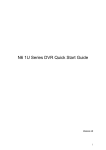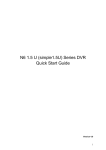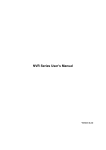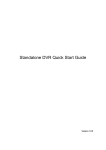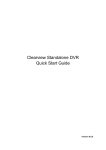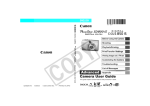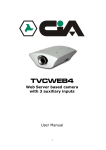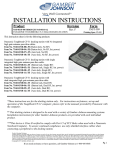Download NVR 6000 Series Quick Start Guide
Transcript
NVR 6000 Series Quick Start Guide V2.0.0 Table of Contents 1 INSTALLATION AND CONNECTIONS ....................................................1 1.1 Check Unpacked NVR............................................................................................................1 1.2 Front Panel ...............................................................................................................................1 1.3 Rear Panel................................................................................................................................2 1.4 Alarm Input and Output Connection .....................................................................................2 1.4.1 Alarm Input and Output Details.........................................................................................3 1.4.2 Alarm Input Port ..................................................................................................................3 1.4.3 Alarm Output Port ...............................................................................................................4 2 OVERVIEW OF NAVIGATION AND CONTROLS ....................................5 2.1 Search & Playback ..................................................................................................................8 2.2 Network ...................................................................................................................................12 2.2.1 Network Setting.................................................................................................................12 2.3 Remote Device ......................................................................................................................13 2.4 Manual Record.......................................................................................................................14 2.4.1 Manual record menu ........................................................................................................14 2.4.2 Basic operation .................................................................................................................14 2.4.3 Enable/disable record ......................................................................................................14 2.4.4 Enable all channel recording...........................................................................................14 2.4.5 Stop all channel recording...............................................................................................15 2.5 Shutdown................................................................................................................................16 i 3 SYSTEM UPGRADE ..............................................................................17 4 WEB OPERATION .................................................................................18 4.1 4.1.1 4.2 General Introduction..............................................................................................................18 Preparation ........................................................................................................................18 Login........................................................................................................................................18 APPENDIX H TOXIC OR HAZARDOUS MATERIALS OR ELEMENTS........21 ii Welcome Thank you for purchasing our NVR! This quick start guide is designed to be a reference tool for the installation and operation of your system. Before installation and operation please read the following safeguards and warnings carefully! Please keep it for future reference! iii Important Safeguards and Warnings 1.Electrical safety All installation and operation here should conform to your local electrical safety codes. We assume no liability or responsibility for all the fires or electrical shock caused by improper handling or installation. 2.Transportation security Heavy stress, violent vibration or water splash are not allowed during transportation, storage and installation. 3.Installation Keep upwards. Handle with care. Do not apply power to the NVR before completing installation. Do not place objects on the NVR. 4.Qualified engineers needed All the examination and repair work should be done by the qualified service engineers. We are not liable for any problems caused by unauthorized modifications or attempted repair. 5.Environment The NVR should be installed in a cool, dry place away from direct sunlight, inflammable, explosive substances and etc. This series product shall be transported, storage and used in the specified environments. 6. Lithium battery Improper battery use may result in fire, explosion, or personal injury! When replace the battery, please make sure you are using the same model! 7. Accessories Be sure to use all the accessories recommended by manufacturer. Before installation, please open the package and check all the components are included. Contact your local retailer ASAP if something is broken in your package. Name Quantity Front panel key 2 HDD screws 68 Quick start guide 1 CD 1 iv 1 Installation and Connections Note: All the installation and operations here should conform to your local electric safety rules. 1.1 Check Unpacked NVR When you receive the NVR from the forwarding agent, please check whether there is any visible damage. The protective materials used for the package of the NVR can protect most accidental clashes during transportation. Then you can open the box to check the accessories. Please check the items in accordance with the list. Finally you can remove the protective film of the NVR. 1.2 Front Panel The front panel is shown as below. See Figure 1-1. Figure 1-1 Please refer to the following sheet for front panel button information. SN Name Function 1 Power button Press it once to turn on the device. Press it for a long time to turn off the device. (Usually we do not recommend). 2 System HDD Indication light The blue light flashes when system is reading or writing the system HDD. In the system HDD, there are device important configuration file, factory default configuration file, and device initial boot up data. 3 Alarm indication light The alarm indication light becomes on once an alarm occurred. The alarm includes hardware alarm, network abnormal events, or system receives the alarm signal and etc. 4 Network indication light The network indication light is blue and it flashes when you connect the device to the network. 5 USB port / 6 Front panel lock / After you remove the front panel, you can see there are 16 HDDs. From the left to the right and 1 from the top to the bottom, it ranges from 1~4, 5~8, 6~12, 13~16. You can see there are two indication lights on the HDD bracket. z The power indication light is at the top. The light is yellow after you connected the device to the power. z The read-write indication light is at the bottom. The blue light flashes when system is reading or writing the data. 1.3 Rear Panel The rear panel is shown as below. See Figure 1-2. Figure 1-2 Please refer to the following sheet for detailed information. SN Function SN Function 1 Power socket 6 Video VGA output 2 Audio Input 7 eSATA port 3 Audio output 8 USB port 4 Bidirectional talk input 9 HDMI port 5 Network port 10 Alarm input, alarm output, RS485 port. 1.4 Alarm Input and Output Connection Please refer to the following sheet for alarm input and output connection. There are two alarm input types for you to select: normal open (NO) and normal close (NC). 1. Alarm input a. Please make sure alarm input mode is grounding alarm input. b. Grounding signal is needed for alarm input. c. Alarm input needs the low level voltage signal. d. Alarm input mode can be either NC (normal Open) or NO (Normal Close) e. When you are connecting two NVRs or you are connecting one NVR and one other device, please use a relay to separate them. 2. Alarm output The alarm output port should not be connected to high power load directly (It shall be less than 1A) to avoid high current which may result in relay damage. Please use the co contactor to 2 realize the connection between the alarm output port and the load. 3. Please make sure the front-end device has soundly earthed. Improper grounding may result in chip damage. 1.4.1 Alarm Input and Output Details You can refer to the following sheet for alarm input and output information. See Figure 1-3. X Figure 1-3 Please refer to the following sheet and Figure 1-3 for detailed information. 1,2,3,4,5,6, ALARM 1 to ALARM 16. The alarm becomes active in low voltage. 7,8,9,10,11, 12,13,14,15,16 1-ON C,2- ON C, Eight groups of normal open activation output (on/off button) 3- ON C,4- ON C, 5- ON C,6- ON C, 7 - ON C,8- ON G GND cable. 485 A/B The A/B cable to control the RS485 devices. It is to connect to control decoder such as the recorder. Tx and Rx RS232 port. Tx is the data output cable and the Rx is the data input cable. 1.4.2 Alarm Input Port Please refer to the following sheet for more information. z Grounding alarm inputs. Normal open or Normal close type) z Please parallel connect COM end and GND end of the alarm detector (Provide external power to the alarm detector). z Please parallel connect the Ground of the NVR and the ground of the alarm detector. z Please connect the NC port of the alarm sensor to the NVR alarm input(ALARM) z Use the same ground with that of NVR if you use external power to the alarm device. 3 Figure 1-4 1.4.3 Alarm Output Port z z z Provide power to peripheral alarm device. To avoid overloading, please read the following relay parameters sheet carefully. RS485 A/B cable is for the A/B cable of the PTZ decoder. Relay Specification Model: JRC-27F Material of the touch Silver Rating(Resistan Rated switch capacity Load) Maximum switch power Insulation Surge voltage 30VDC 2A, 125VAC 1A 125VA 160W Maximum switch voltage 250VAC, 220VDC Maximum switch currency 1A Between touches with same polarity 1000VAC 1minute Between touches with different polarity 1000VAC 1minute Between touch and winding 1000VAC 1minute Between touches with same polarity 1500V (10×160us) Length of open time 3ms max Length of close time 3ms max Longevity Mechanical 50×106 times (3Hz) Electrical 200×103 times (0.5Hz) Temperature -40℃ ~+70℃ 4 2 Overview of Navigation and Controls Connect the device to the monitor and then connect a mouse and power cable. Click the power button at the front panel and then boot up the device to view the analog video output. You can use the mouse to implement some GUI operation. Right click mouse, you can see system pops up the login interface for you to input user name and password. You can use USB mouse to input. Click to switch between numeral, English character (small/capitalized) and denotation. Note: For security reason, please modify password after you first login. Within 30 minutes, three times login failure will result in system alarm and six times login failure will result in account lo Figure 2-1 After device booted up, the system is in multiple-channel display mode. See Figure 2-2.Please note the displayed window amount may vary. The following figure is for reference only. Figure 2-2 You can overlay the corresponding date, time and channel name on each screen. You can refer to the following sheet for channel record or alarm status information. 5 1 Recording status 3 Video loss 2 Motion detection 4 Monitor lock Navigation bar The navigation bas is shown as below. See Figure 2-3. Figure 2-3 ①:Main interface ②:Output screen option: Select corresponding output device and set the output window amount. ③:Window split: System supports 1/4/8/9/16/25/36/64-window output mode. Please select the window mode and then select the corresponding channels. ④:PTZ Setup The PTZ setup is shown as in Figure 2-4. Please note the commend name is grey once device does not support this function. Double click the title to hide the PTZ menu interface. Here you can control PTZ direction, speed, zoom, focus, iris, preset, tour, scan, pattern aux function, light and wiper, rotation and etc. Speed is to control PTZ movement speed. The value ranges from 1 to 8.The speed 8 is faster than speed 1. You can use the remote control to click the small keyboard to set. You can click and of the zoom, focus and iris to zoom in/out, definition and brightness. The PTZ rotation supports 8 directions. Figure 2-4 ⑤:Record Search It is a shortcut search menu. Please refer to chapter 2.4 for detailed information. ⑥:Alarm Info The alarm information is shown as below. See Figure 2-5. 6 It is for you to set the alarm information of current channel. Figure 2-5 ⑦:Network Setup It is the shortcut network setup button. Please refer to chapter 2.2 for detailed information. ⑧:HDD management It is the shortcut HDD management button. Please refer to 错误!未找到引用源。 for detailed information. ⑨:Device management You can use the channel list and the device list to manage the connected remote device. The channel list is on the left. Here you can view all connected channel information. The green color in front of the camera name means current channel is recording now. The grey color means current channel is not recording. The device list is on the right. Here you can view connected device information. Green icon means current device is online while the red cross means current device is offline. See Figure 2-6. 7 Figure 2-6 2.1 Search & Playback Click search button in the main menu, or you can right click mouse and then select the Search item. Search interface is shown as below. See Figure 2-7. Please note the initial version does not support smart search, card number search and picture operation. 8 2 1 3 4 11 7 6 5 10 8 9 12 Figure 2-7 Please refer to the following sheet for more information. SN 1 2 3 4 Name Function Display window zHere is to display the searched picture or file. zSupport 1/4/9/16-window playback. Search type zHere you can select to search the picture or the recorded file. zWhen there is displayed picture on the left pane, you can set the corresponding setup Calendar zThe blue highlighted date means there is picture or file. Otherwise, there is no picture or file. zIn any play mode, click the date you want to see, you can see the corresponding record file trace in the time bar. Playback mode and channel selection pane. zPlayback mode:1/4/9/16. (It may vary due to different series.) In 1-window playback mode: you can select 1-128 channels. In 4-window playback mode: you can select 4 channels according to your requirement such as channel 1-4,5-8…125-128. In 9-window playback mode, you can switch between 1-8,9-16…121-128 channels. In 16-window playback mode, you can switch between 1-16, 17-32…113-128 channels. zThe time bar will change once you modify the playback mode or the channel 9 option. 5 File list switch button 6 Card number search 7 Playback control pane. zDouble click it, you can view the picture/record file list of current day. zThe file list is to display the first channel of the record file. zThe system can display max 128 files in one time. Use middle button of the mouse to view the file. Select one item, and then double click the mouse or click the ENTER button to playback. zYou can input the period in the following interface to begin accurate search. zFile type:R—regular record; A—external alarm record;M—Motion detect record. The card number search interface is shown as below. ►/ Play/Pause There are three ways for you to begin playback. z The play button z Double click the valid period of the time bar. z Double click the item in the file list. In slow play mode, click it to switch between play/pause. ■ Stop button. W Backward play In normal play mode, left click the button, the file begins backward play. Click it again to pause current play. In backward play mode, click ►/ to restore normal play. │W/ X│ In playback mode, click it to play the next or the previous section. You can click continuously when you are watching the files from the same channel. In normal play mode, when you pause current play, you can click W│ and │X to begin frame by frame playback. In frame by frame playback mode, click ►/ to restore normal playback. ► Slow play In playback mode, click it to realize various slow play modes such as slow play 1, slow play 2, and etc. Fast forward In playback mode, click to realize various fast play modes such as fast play 1,fast play 2 and etc. Note: The actual play speed has relationship with the software version. Smart search The volume of the playback Current series device does not support snapshoot function now. 8 Time bar zIt is to display the record type and its period in current search criteria. 10 zIn 4-window playback mode, there are corresponding four time bars. In other playback mode, there is only one time bar. zUse the mouse to click one point of the color zone in the time bar, system begins playback. zThe time bar is beginning with 0 o'clock when you are setting the configuration. The time bar zooms in the period of the current playback time when you are playing the file. zThe green color stands for the regular record file. The red color stands for the external alarm record file. The yellow stands for the motion detect record file. 9 10 Time bar unit ●The option includes: 24H, 12H, 1H and 30M. The smaller the unit, the larger the zoom rate. You can accurately set the time in the time bar to playback the record. zThe time bar is beginning with 0 o'clock when you are setting the configuration. The time bar zooms in the period of the current playback time when you are playing the file. Backup Select the file(s) you want to backup from the file list. System max supports files from four channels. Then click the backup button, now you can see the backup menu. Click the start button to begin the backup operation. Check the file again you can cancel current selection. System max supports to display 32 files from one channel. z z 11 Clip 12 Record type In any play mode, the time bar will change once you modify the search type. z 13 Smart search It is to edit the file. Please play the file you want to edit and then click this button you can see the time control. Select the start time and end time on the right side and click this button again, you can see the backup data to be saved in the pop-up dialogue box. Click this button again to exit the clip mode. z z z z When system is playing, you can select a zone in the window to begin motion detect. Click the motion detect button to begin play. Current button is null once the motion detect play has begun. The system will take the whole play zone as the motion detect region by default. The motion detect play stopped once you switch the play file. Operations such as set time bar, click the play button, or any file list operation will stop current motion detect play. Other Functions 14 Digital zoom When the system is in full-screen playback mode, left click the mouse in the screen. Drag your mouse in the screen to select a section and then left click mouse to realize digital zoom. You can right click mouse to exit. Note: All the operations here (such as playback speed, channel, time and progress) have relationship with hardware version. Some series NVRs do not support some functions or playback speeds. 11 2.2 Network Here is for you to input network information. See Figure 2-8. z IP address: Here you can use up/down button (ST) or input the corresponding number to input IP address. Then you can set the corresponding subnet mask the default gateway. z DHCP: It is to auto search IP. When enable DHCP function, you can not modify IP/Subnet mask /Gateway. These values are from DHCP function. If you have not enabled DHCP function, IP/Subnet mask/Gateway display as zero. You need to disable DHCP function to view current IP information. Besides, when PPPoE is operating, you can not modify IP/Subnet mask /Gateway. z IP version: It supports IPv4. z TCP port: Default value is 37777. You can change if necessary. z UDP port: Default value is 37778. You can change if necessary. z HTTP port: Default value is 80. z RTSP port: Default value is 554. Important: System needs to reboot after you changed and saved any setup of the above four ports. Please make sure the port values here do not conflict. z Max connection: system support maximal 20 users. 0 means there is no connection limit. z Preferred DNS server: DNS server IP address. z Alternate DNS server: DNS server alternate address. z Transfer mode: Here you can select the priority between fluency/video qualities. z LAN download: System can process the downloaded data first if you enable this function. The download speed is 1.5X or 2.0X of the normal speed. After completing all the setups please click save button, system goes back to the previous menu. Figure 2-8 2.2.1 Network Setting Network setting interface is shown as in Figure 2-9. Please draw a circle to enable 12 corresponding function and then double click current item to go to setup interface. Figure 2-9 2.3 Remote Device In the main menu, click the Remote Device icon to go to the corresponding interface. The remote device interface is shown as in Figure 2-10. z Device search: Click it to search IP address. z Add: Click it to connect to the selected device and add it to the Added device list. Support Batch add. z Show filter: You can use it to display the specified devices from the added device. z Delete: Please select one device in the Added device list and then click it to remove. z Manual add: Click it to add the IPC manually. The port number is 37777. The default user name is admin and password is admin. Figure 2-10 13 You can go to remote device information interface (Main menu->Info->Remote device info) to view remote device information such as channel status, connection log, load balance and etc. 2.4 Manual Record Note: You need to have proper rights to implement the following operations. Please make sure the HDD has been properly installed. 2.4.1 Manual record menu Right click mouse or in the main menu, from Advanced->Manual Record, you can see manual record menu is shown as in Figure 2-11. You can click the PgUp/PgDn button to view more channels. 2.4.2 Basic operation There are three statuses: schedule/manual/stop. Please highlight icon“○” to select corresponding channel. z Manual: The highest priority. After manual setup, all selected channels will begin ordinary recording. z Schedule: Channel records as you have set in recording setup (Main Menu->Setting->Schedule) z Stop: All channels stop recording. Figure 2-11 2.4.3 Enable/disable record Please check current channel status: “○” means it is not in recording status, “●” means it is in recording status. You can use mouse or direction key to highlight channel number. See Figure 2-12. Figure 2-12 2.4.4 Enable all channel recording 14 Highlight ○ below All, you can enable all channel recording. z All channel schedule record Please highlight “ALL” after “Schedule”. See Figure 2-13. When system is in schedule recording, all channels will record as you have previously set (Main menu->Setting->Schedule). The corresponding indication light in front panel will turn on. Figure 2-13 z All channel manual record Please highlight “ALL” after “Manual.” See Figure 2-14. When system is in manual recording, all scheduled set up you have set in will be null ((Main menu->Setting->Schedule)). You can see indication light in front panel turns on, system begins manual record now. Figure 2-14 2.4.5 Stop all channel recording Please highlight “ALL” after “Stop”. See Figure 2-15. System stops all channel recording no matter what mode you have set in the menu (Main menu->Setting->Schedule) Figure 2-15 15 2.5 Shutdown Double click shutdown button, system pops up a dialogue box for you to select. See Figure 2-16. z Logout menu user: log out menu. You need to input password when you login the next time. z Restart application: reboot device. z Shutdown: system shuts down and turns off power. z Restart system: system begins rebooting. z Switch user: you can use another account to login. If you shut down the device, there is a process bar for your reference, system waits for 3 seconds and then shut down (You can not cancel). Please note, sometimes you need to input the proper password to shut down the device. Figure 2-16 16 3 System Upgrade There are two ways for you to update the NVR: you can use update tool of the Windows or the flash drive. Please visit our website or contact our technical engineer to get the update tool for Windows. You can use NVR upgrade or ConfigTool. Please update manually if the ConfigTool can not find the device. Please follow the steps listed below to use the DVR Upgrade tool. See Figure 3-1. 1) Open the update tool and input device IP address and TCP port value (Usually it is 3777). The application layer software did not enable successfully if you can not update via port 3777. Then you can use port 3800 to update. 2) Click the Login button on the right side, system pops up a dialogue box. Here you can input user name (admin) and password (admin). Click the OK button, you can login. And you can see the Login button becomes Logout. 3) Click the Open files button and then select the upgrade file, click the BIOS button to update. Figure 3-1 Or, you can use the flash drive to update. Please copy the update file to the flash drive and make sure the update file is update.bin. Insert the flash drive to one of the USB port. From the Main menu-Info->Version, click the Start button to begin update. See Figure 3-2. Figure 3-2 17 4 WEB OPERATION 4.1 General Introduction The device web provides channel monitor menu tree, search, alarm setup, system setup, PTZ control and monitor window. 4.1.1 Preparation Before log in, please make sure: z PC and NVR connection is OK. z You have set PC IP address, NVR IP address, subnet mask and gateway. (Please set the IP address of the same section for the PC and NVR. Please input corresponding gateway and subnet mask if there are routers.) z Use order ping ***.***.***.***(NVR IP address) to check connection is OK or not. 4.2 Login Open IE and input NVR address in the address column. For example, if your NVR IP is 10.10.3.16, then please input http:// 10.10.3.16 in IE address column. See Figure 4-1. Input your IP address here. Figure 4-1 System pops up warning information to ask you whether install webrec.cab control or not. Please click yes button. If you can’t download the ActiveX file, please modify your settings as follows. See Figure 4-2. 18 Figure 4-2 After installation, the interface is shown as below. See Figure 4-3. Please input your user name and password. Default factory name is admin and password is admin. Note: For security reasons, please modify your password after you first login. Figure 4-3 After you logged in, you can see the main window. See Figure 4-4. Please click the channel name on the left pane to begin real-time monitor. 19 Figure 4-4 For detailed operation instruction, please refer to user’s manual included in the resources CD. 20 Appendix H Toxic or Hazardous Materials or Elements Component Name Toxic or Hazardous Materials or Elements Pb Hg Cd Cr VI PBB PBDE Sheet Metal(Case) ○ ○ ○ ○ ○ ○ Plastic Parts (Panel) ○ ○ ○ ○ ○ ○ Circuit Board ○ ○ ○ ○ ○ ○ Fastener ○ ○ ○ ○ ○ ○ Wire and Cable/AC Adapter ○ ○ ○ ○ ○ ○ Packing Material ○ ○ ○ ○ ○ ○ Accessories ○ ○ ○ ○ ○ ○ O: Indicates that the concentration of the hazardous substance in all homogeneous materials in the parts is below the relevant threshold of the SJ/T11363-2006 standard. X: Indicates that the concentration of the hazardous substance of at least one of all homogeneous materials in the parts is above the relevant threshold of the SJ/T11363-2006 standard. During the environmental-friendly use period (EFUP) period, the toxic or hazardous substance or elements contained in products will not leak or mutate so that the use of these (substances or elements) will not result in any severe environmental pollution, any bodily injury or damage to any assets. The consumer is not authorized to process such kind of substances or elements, please return to the corresponding local authorities to process according to your local government statutes. Note: z For detailed operation introduction, please refer to our resource CD included in your package for electronic version of the User’s Manual. z This quick start guide is for reference only. Slight difference may be found in the user interface. z All the designs and software here are subject to change without prior written notice. z All trademarks and registered trademarks mentioned are the properties of their respective owners. z If there is any uncertainty or controversy, please refer to the final explanation of us. z Please visit our website or contact your local retailer for more information. 21


























